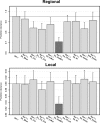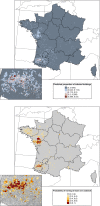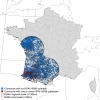Duck production systems and highly pathogenic avian influenza H5N8 in France, 2016-2017
- PMID: 30992486
- PMCID: PMC6467959
- DOI: 10.1038/s41598-019-42607-x
Duck production systems and highly pathogenic avian influenza H5N8 in France, 2016-2017
Abstract
In winter 2016-2017, Highly Pathogenic Avian Influenza (HPAI) H5N8 virus spread across Europe, causing unprecedented epizootics. France was massively affected, resulting in the culling of over 6 million poultry. Boosted regression tree (BRT) models were used to quantify the association between spatial risk factors and HPAI H5N8 infection in poultry holdings and to generate predictive maps for HPAI infection. Three datasets were combined to build the model: a dataset of the reported outbreaks in poultry, a dataset of the poultry holdings where the virus has not been reported and a set of relevant spatial risk factors, including poultry production and trade, and water bird habitat. Results identified key associations between the 'foie gras' production systems and HPAI H5N8 risk of occurrence and indicate that strengthening surveillance of fattening duck production systems and making the transportation of fattening ducks more secure would be key priority options for HPAI prevention and control.
Conflict of interest statement
The authors declare no competing interests.
Figures




Similar articles
-
Spatio-temporal patterns of highly pathogenic avian influenza virus subtype H5N8 spread, France, 2016 to 2017.Euro Surveill. 2018 Jun;23(26):1700791. doi: 10.2807/1560-7917.ES.2018.23.26.1700791. Euro Surveill. 2018. PMID: 29970219 Free PMC article.
-
Risk factors associated with highly pathogenic avian influenza subtype H5N8 outbreaks on broiler duck farms in South Korea.Transbound Emerg Dis. 2018 Oct;65(5):1329-1338. doi: 10.1111/tbed.12882. Epub 2018 Apr 19. Transbound Emerg Dis. 2018. PMID: 29673109
-
Characterization of highly pathogenic avian influenza H5N8 virus from Egyptian domestic waterfowl in 2017.Avian Pathol. 2018 Aug;47(4):400-409. doi: 10.1080/03079457.2018.1470606. Epub 2018 May 30. Avian Pathol. 2018. PMID: 29701481
-
Biosecurity risk factors for highly pathogenic avian influenza (H5N8) virus infection in duck farms, France.Transbound Emerg Dis. 2020 Nov;67(6):2961-2970. doi: 10.1111/tbed.13672. Epub 2020 Jul 2. Transbound Emerg Dis. 2020. PMID: 32526101
-
Natural and Experimental Persistence of Highly Pathogenic H5 Influenza Viruses in Slurry of Domestic Ducks, with or without Lime Treatment.Appl Environ Microbiol. 2020 Nov 24;86(24):e02288-20. doi: 10.1128/AEM.02288-20. Print 2020 Nov 24. Appl Environ Microbiol. 2020. PMID: 33008818 Free PMC article.
Cited by
-
Risk factors for avian influenza in Danish poultry and wild birds during the epidemic from June 2020 to May 2021.Front Vet Sci. 2024 Feb 21;11:1358995. doi: 10.3389/fvets.2024.1358995. eCollection 2024. Front Vet Sci. 2024. PMID: 38450025 Free PMC article.
-
Surveillance Strategy in Duck Flocks Vaccinated against Highly Pathogenic Avian Influenza Virus.Emerg Infect Dis. 2025 Jan;31(1):115-122. doi: 10.3201/eid3101.241140. Epub 2024 Dec 19. Emerg Infect Dis. 2025. PMID: 39699551 Free PMC article.
-
Investigating the role of environmental factors in the French highly pathogenic avian influenza epizootic in 2022-2023.Front Vet Sci. 2025 Jun 13;12:1541019. doi: 10.3389/fvets.2025.1541019. eCollection 2025. Front Vet Sci. 2025. PMID: 40586036 Free PMC article.
-
Using homologous network to identify reassortment risk in H5Nx avian influenza viruses.PLoS Comput Biol. 2025 Jul 22;21(7):e1013301. doi: 10.1371/journal.pcbi.1013301. eCollection 2025 Jul. PLoS Comput Biol. 2025. PMID: 40694591 Free PMC article.
-
Knowledge and remaining gaps on the role of animal and human movements in the poultry production and trade networks in the global spread of avian influenza viruses - A scoping review.PLoS One. 2020 Mar 20;15(3):e0230567. doi: 10.1371/journal.pone.0230567. eCollection 2020. PLoS One. 2020. PMID: 32196515 Free PMC article.
References
-
- EFSA. Scientific Report on Avian influenza overview October 2016 - August 2017 [Available at, https://www.efsa.europa.eu/en/efsajournal/pub/5018 (Accessed in October 2017)] (2017).
Publication types
MeSH terms
LinkOut - more resources
Full Text Sources
Medical

